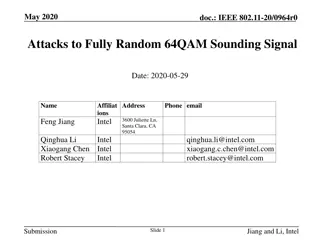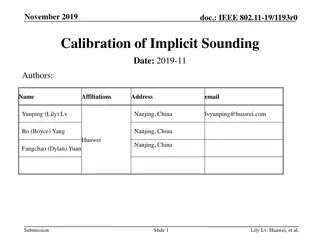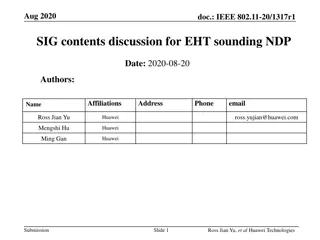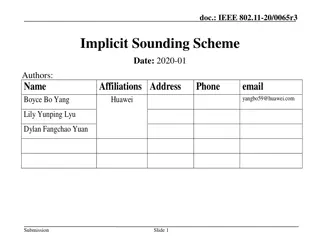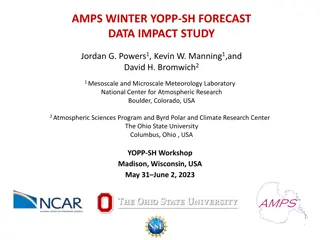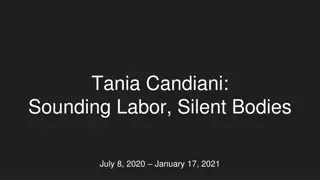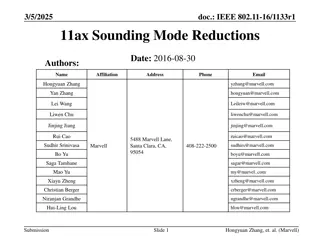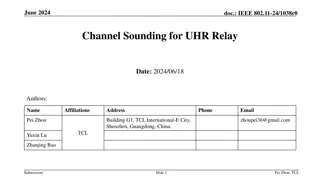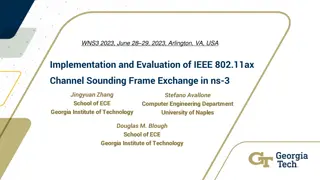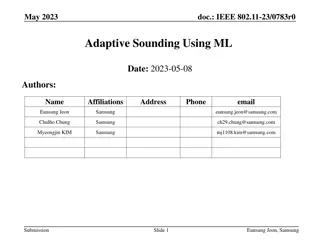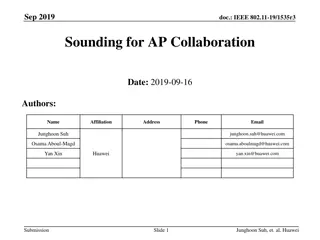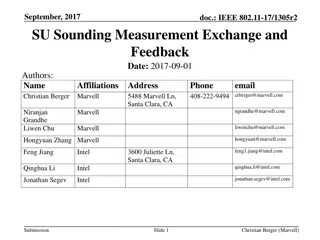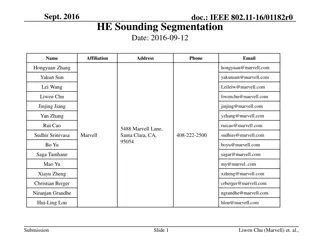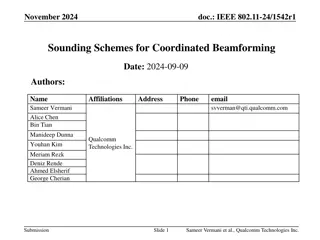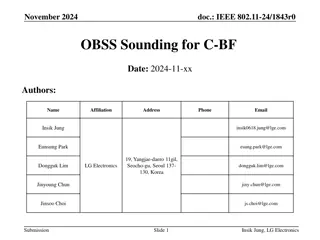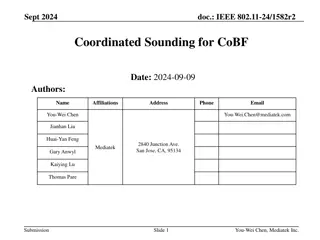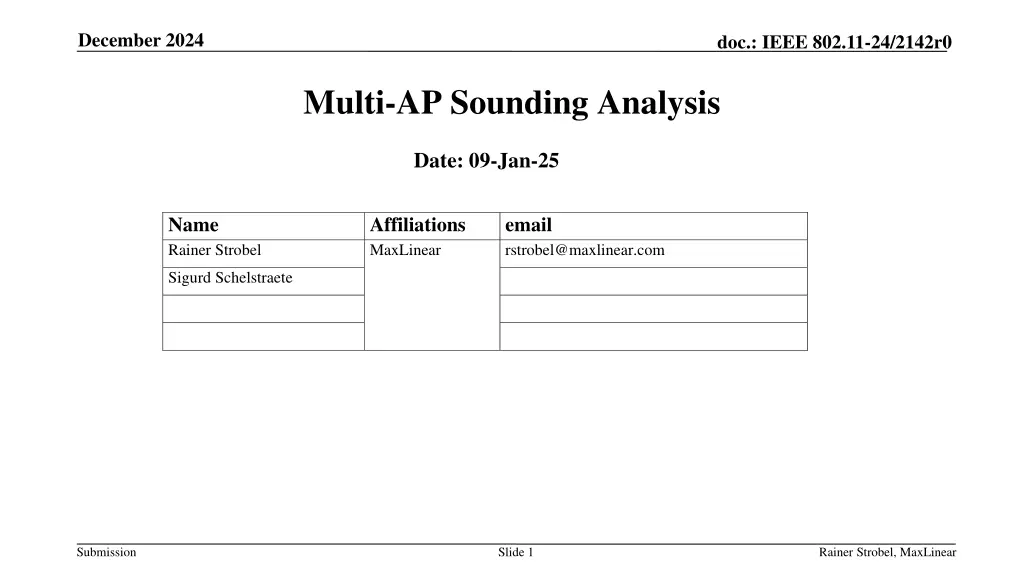
IEEE 802.11-24/2142r0 Multi-AP Sounding Analysis Update
Explore the latest developments in multi-AP sounding protocols in the December 2024 document IEEE 802.11-24/2142r0. Analysis includes overhead assessment, timing impairments, and optimization of precoding matrices for improved performance. Issues regarding joint sounding overhead and possible improvements are thoroughly examined in this comprehensive review.
Download Presentation

Please find below an Image/Link to download the presentation.
The content on the website is provided AS IS for your information and personal use only. It may not be sold, licensed, or shared on other websites without obtaining consent from the author. If you encounter any issues during the download, it is possible that the publisher has removed the file from their server.
You are allowed to download the files provided on this website for personal or commercial use, subject to the condition that they are used lawfully. All files are the property of their respective owners.
The content on the website is provided AS IS for your information and personal use only. It may not be sold, licensed, or shared on other websites without obtaining consent from the author.
E N D
Presentation Transcript
December 2024 doc.: IEEE 802.11-24/2142r0 Multi-AP Sounding Analysis Date: 09-Jan-25 Name Rainer Strobel Affiliations MaxLinear email rstrobel@maxlinear.com Sigurd Schelstraete Submission Slide 1 Rainer Strobel, MaxLinear
December 2024 doc.: IEEE 802.11-24/2142r0 Introduction Multi-AP Sounding protocols have been proposed in [1, 2] Joint Sounding Sequential Sounding Submission Slide 2 Rainer Strobel, MaxLinear
December 2024 doc.: IEEE 802.11-24/2142r0 Problem Statement Sounding overhead needs to be considered Clock synchronization between joint sounding APs is a non-trivial requirement COBF performance depends on sounding and precoding algorithm Joint sounding allows partial rank nulling, butwithout joint optimization doesn t perform well Sequential sounding without partial rank nulling is limited to 1-antenna STAs and 2-spatial stream transmissions In this contribution: We assess overhead impact of the current sounding proposals We analyze (timing) impairments for joint sounding We analyze joint optimization of precoding matrices Submission Slide 3 Rainer Strobel, MaxLinear
December 2024 doc.: IEEE 802.11-24/2142r0 Issue 1: Sounding Overhead Joint Sounding (single instance) 2 APs (4 ant.) , 4 STAs (2 ant.), 1 or 2 spatial streams, 160MHz NDPA1 64 s+16 s NDP1 2x LTF, 8 streams 108 s BFRP1 64 s+16 s Feedback 1 @ MCS 0: 100/54 symbols =>1644 s/908 s+16 s NDPA2 64 s+16 s NDP2 2x LTF, 8 streams 108 s BFRP2 64 s+16 s Feedback 2 @ MCS 0: 100/54 symbols => 1644 s/908 s +16 s (8x2=>26 angles, 8x1=>14 angles 7/9 bits, grouping 4=>468 carriers) 97344 bit or 52416 bit, with 980 bit per data symbol Sounding feedback overhead of joint sounding is prohibitive: up to 4ms, if all STAs transmit feedback at different times and minimum rate More aggressive rates are problematic because feedback must be received by both APs Submission Slide 4 Rainer Strobel, MaxLinear
December 2024 doc.: IEEE 802.11-24/2142r0 Possible Improvements Single NDP transmission (trigger + NDPA1/2 + NDP) Trigger+NDPA1 2 x (64 s+16 s) NDP1 2x LTF, 8 streams 108 s Dedicated feedback to associated AP and feedback exchange on DS BFRP1 64 s+16 s Feedback 1 mcs5: 13/7 symbols =>256 s/160 s+16 s BFRP2 64 s+16 s Feedback 2 mcs5: 13/7 symbols => 256 s/160 s +16 s Sounding overhead time around 0.8 msec Submission Slide 5 Rainer Strobel, MaxLinear
December 2024 doc.: IEEE 802.11-24/2142r0 Sounding Overhead Sequential Sounding 2 APs, 4 STAs, with 4/2 antennas, 1 or 2 spatial streams, 160MHz NDPA1-1 64 s+16 s NDP1-1 76 s+16 s BFRP1-1 64 s+16 s Feedback1-1 mcs5: 96 s+16 s NDPA2-2 64 s+16 s NDP2-2 76 s+16 s BFRP2-2 64 s+16 s Feedback 2-2 mcs5: 96 s +16 s NDPA1-2 NDP1-2 BFRP1-2 Feedback1-2 NDPA2-1 NDP2-1 BFRP2-1 Feedback 2-2 64 s+16 s 76 s+16 s 64 s+16 s mcs1: 240 s+16 s 64 s+16 s 76 s+16 s 64 s+16 s mcs1: 240 s+16 s (4x2=>10 angles, 4x1=>6 angles 4/6 bits, grouping 4=>468 carriers) 37440 bit or 22464 bit, with 980 bit per data symbol Lower overhead time (1.8ms), but feedback to un-associated APs (intra- OBSS) is not efficient (per-antenna feedback needed, conservative mcs, because channel is not known) Mcs1 is used for feedback, because there is a single dedicated receipient Submission Slide 6 Rainer Strobel, MaxLinear
December 2024 doc.: IEEE 802.11-24/2142r0 Possible Improvements for sequential sounding intra- OBSS feedback Sequential sounding according to [1, 2] doesn t allow for partial rank nulling. This can be resolved by defining a new feedback report for intra-OBSS feedback [5, 6]. Associated STA channel: ?s1a1= ??1?1??1?1??1?1 Intra-OBSS feedback?s1a2: ?s1a1 Channel: ?s1a1 ?s2?1 ?s2a2 H 1?s1a1 H ?s1a2 ?s1a2 Submission Slide 7 Rainer Strobel, MaxLinear
December 2024 doc.: IEEE 802.11-24/2142r0 Sounding Interval 2 STAs per AP Performance degrades over time Different precoding methods were considered: Zero-forcing (perfect nulls) Partial nulling (regularized inversion) IPO (iterative phase optimization) joint optimization Sounding Interval About 20ms sounding interval is needed to maintain consistent performance With 4ms per sounding, this amounts to 20% total overhead, with 0.8ms, overhead reduces to 4% 1 STA per AP Simulation: Joint sounding, 2 APs, D NLOS channel with 1.2km/h movement Submission Slide 8 Rainer Strobel, MaxLinear
December 2024 doc.: IEEE 802.11-24/2142r0 Issue 2: Joint Sounding Impairments Joint Sounding and CFO In joint sounding, a clock offset between the two APs causes a channel estimation error, because the STA can lock to only one of the APs Due to the duration of the joint sounding LTFs, the frequency drift within the LTFs can cause a performance impact Not an issue for sequential sounding Performance penalty of CFO during transmisson of 8 LTFs Simulation: 4x LTFs, 4-antenna AP, 2-antennas STAs (joint, sequential non-standard), 1-antenna STA (sequential), CFO as in trigger-based Submission Slide 9 Rainer Strobel, MaxLinear
December 2024 doc.: IEEE 802.11-24/2142r0 Issue 3: COBF Performance Performance depends on RX equalization of multi-antenna STAs 1. Joint Sounding: ??= ?? 2. Independent Sounding: ??= ??? 3. Joint Optimization: ??jointly optimized for all STAs ? = 1, ,? Optimization background: 1?? ? 1??? ? 1 ?1 ? ? ?2 ?1a ?2a ?3a ?4a ? ? ?4 G= , ??= ??1 ??2 , ?a= G ?3 ? ? Fix ??1 search ??2 for best conditioning of ?a matrix inversion, e.g. by the iterative phase optimization (IPO) method described in [10] Submission Slide 10 Rainer Strobel, MaxLinear
December 2024 doc.: IEEE 802.11-24/2142r0 Joint Optimization Feedback exchange phase allows to jointly optimize precoding Use the best possible equalizer rather than ?? or ??? Top figure indepenent nulling Bottom figure is joint optimization of nulling (50% higher rates avg.) STAs associated with AP1 STAs associated with AP2 Hfrom joint sounding Hfrom independent sounding AP1 AP2 STAs associated with AP1 STAs associated with AP2 AP1 AP2 Submission Slide 11 Rainer Strobel, MaxLinear
December 2024 doc.: IEEE 802.11-24/2142r0 Conclusions Sounding Overhead 20ms sounding interval seems acceptable for good spatial nulling performance. Without improvements, joint sounding overhead is problematic (up to 20% overhead for 2 STAs per AP) Joint sounding issues CFO in joint sounding results in a channel estimation error (even with aggressive assumption on precompensation), which is not the case for sequential sounding Independent sounding has advantages Dedicated feedback for data and nulling, which can be optimized for the needs (e.g., do sounding for nulling less frequently). Feedback packets have a specific recipient, which allows higher rates Submission Slide 12 Rainer Strobel, MaxLinear
December 2024 doc.: IEEE 802.11-24/2142r0 References [1] Sameer Vermani et.al., Sounding Schemes for Coordinated Beamforming , IEEE 802.11-24/1542 September 2024 [2] Ron Porat et.al., Sounding Design for C-BF , IEEE 802.11-24/1568 September 2024 [3] Insing Jung et.al., Coordinated Beamforming for 11bn Follow Up , IEEE 802.11-24/1515r2 September 2024 [3] Aiguo Yan et.al., Unified CoBF/MUMIMO Schemes with Zero-MUI , IEEE 802.11-24/1432r2 August 2024 [4] Shimi Shilo et.al., Coordinated BF: Figures of Merit , IEEE 802.11-24/1484r0 September 2024 [5] Shimi Shilo et.al., Zero MUI Coordinated BF , IEEE 802.11-23/1998r0 November 2023 [6] Rainer Strobel et.al, Coordinated Spatial Nulling (C-SN) Concept , , IEEE 802.11-24/0011r0 January 2024 [7] Rainer Strobel et.al, Coordinated Spatial Nulling (C-SN) Simulations , , IEEE 802.11-24/0012r0 January 2024 [8] Rainer Strobel et.al, Coordinated Spatial Re-Use and Coordinated Spatial Nulling Follow-Up , , IEEE 802.11-2 4/0635r0 March 2024 [9] Alfred Asterjadhi, TGbn Motions List Part 1 , , IEEE 802.11-24/171r19 January 2024 [10] Strobel, Rainer, Avi Mansour, and Ziv Avital. "Uplink and Downlink Precoding for Ultra High Reliability WLAN." ICC 2024-IEEE International Conference on Communications. IEEE, 2024. Submission Slide 13 Rainer Strobel, MaxLinear
December 2024 doc.: IEEE 802.11-24/2142r0 APPENDIX Submission Slide 14 Rainer Strobel, MaxLinear
December 2024 doc.: IEEE 802.11-24/2142r0 Simulation parameters Parameter Value TX/RX Antennas 4/2 APs/STAs 2/4 Spatial streams 1 Bandwidth 160 MHz AP TX Power 21 dBm Channel model D NLOS [8] MCS 0-13 (optimized) Frequency 5 GHz GI 1.6 s TX/RX SNR As on 42/40dB Channel aging/Doppler 1.2km/h, 6Hz BF quantization ideal Precoder type Zero-forcing, joint or independent Overhead Sounding and MAC overhead not considered Submission Slide 15 Rainer Strobel, MaxLinear

